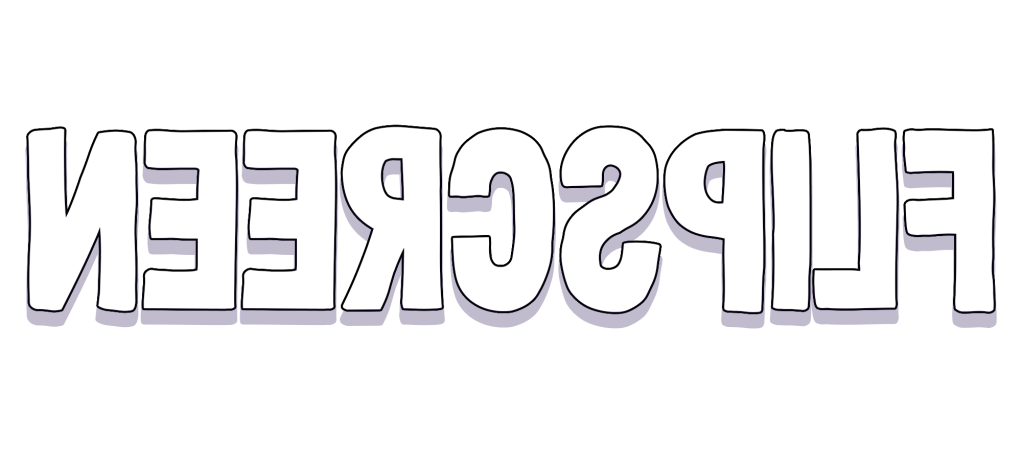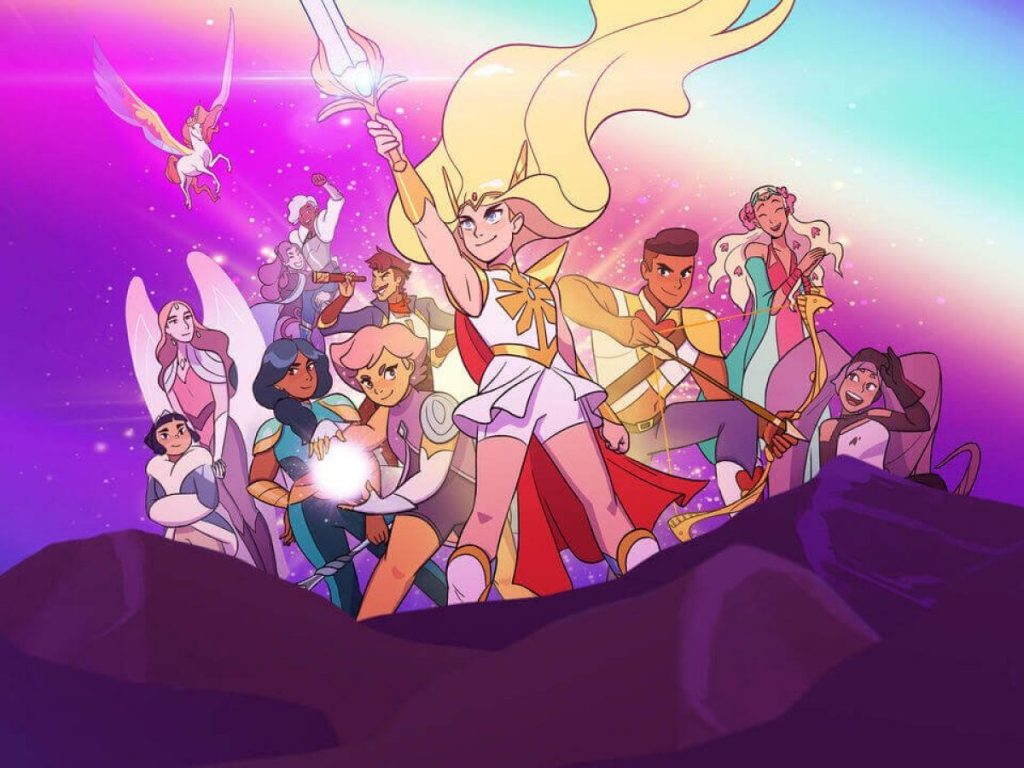[For the Honor of Grayskull, minor spoilers ahead.]
She-Ra and the Princesses of Power, Netflix’s reboot of the popular 1980s cartoon, has been continually praised for its inclusion of queer characters and themes throughout its five season run. This should come as no surprise, having been developed by openly queer Eisner award-winning cartoonist and animation producer Noelle Stevenson; her hands are always ones we can trust. With it’s celestial world full of captivating lore and engaging stories of war and friendship, She-Ra gives us so much to love. However, in this world of magic and mayhem, it is its casual representation of queer characters that establishes She-Ra as one of the best shows on TV.
Set on the planet Etheria, She-Ra follows orphan Adora (Aimee Carrero) who is taken in as a baby by the evil Horde. This tyrannical empire, led by the mysterious Lord Hordark, prepares Adora for a life as Force Captain, leading fleets to take down Etheria’s Princesses. Now eighteen years old, Adora is captured by Princess Glimmer of Brightmoon (Karen Fukuhara) and archer Bow (Marcus Scriber) after having found a magical sword that gives her the power to transform into the legendary Princess – the titular She-ra. After seeing the devastation caused by the Horde on the people and planet of Etheria, Adora joins the Rebellion and works with her newfound friends to reunite the Princess Alliance against the growing danger, even if it means turning against her own. It is a tale of struggle and our Princesses don’t get it easy. But they are fighting for a better world and are allowed to be as queer as they like doing so.

In the opening scene of the show, we get a glimpse at the complex queer relationship at the heart of She-Ra. Catra (AJ Michalka) and Adora mourn, with real heartbreak, their upcoming separation as Adora announces her promotion to the front lines. Going out for one last joyride, the two celebrate their friendship and jokingly fight to steer the stolen speeder they took to sneak out of the Horde’s watch but cry out with devastation for each other when, unsurprisingly, they crash and are ultimately lost from each other for good. As the show goes on, this distance between them grows. We don’t see much of their history, what we do see is the betrayal that is shared between them. Catra cannot forgive Adora for leaving her and joining the rebellion so quickly, while Adora resents Catra for continuing to refuse her olive branch and leave the Horde for good. However, it is clear to the audience that, in spite of their actions, what these former best-friends turned to reluctant enemies really want is just to come back to each other. Their hope that the other will give in and return to them is seen in every moment Catra lashes out or Adora hesitates to strike. The dialogue doesn’t try to hide it either: Catra asks, “This is what you left me for?” during the season one finale, ‘The Battle for Bright Moon’, Adora tells her “You don’t have to go back there” in ‘The Sword: Part 2’, while the plea “You don’t have to do this” becomes almost a catchphrase for Adora, so desperate for Catra’s redemption.
Immediately after the show’s release, it was this relationship that connected with fans. Audiences didn’t feel like they were just ‘reading into’ Adora and Catra’s connection – the queer subtext read more like a plot point that wasn’t quite ready to be laid out in full – and consequently, nobody could stop talking about it. At the heart of their relationship is friendship, one that is far from perfect. They each have issues to deal with on their own and fans identify with that. Perhaps those issues are more galactic in scale, but the core idea that flawed queer people are deserving of love just like anyone else is something incredibly powerful. For LGBT+ fans watching the show, ‘CatrAdora’ became a beacon of hope, and a sign that genuine queer love is in reach for every hero and villain.

The power of having a shows’ protagonist and quasi-antagonist being queer is one thing – it’s fair to say they have set a new standard for LGBT+ representation as they prove we can be successful in more roles than just background ones. But Catra and Adora’s queer beginnings aren’t the only thing evident from season one; She-Ra is sweepingly inclusive. Married Princesses, Netossa (Krystal Joy Brown) and Spinerella (Noelle Stevenson herself) make their first appearance in ‘Flowers for She-Ra’, the fourth episode of the show, where they meet the Best Friends Squad at the War Council hand in hand, making them the first confirmed queer couple in the show. Steady throughout, and given a more prominent role in the final season, the pair are never questioned about being wives but instead about being leaders, and more often about who is the more competitive in the relationship. (It’s definitely Netossa.)
George (Chris Jai Alex) and Lance (Regi Davis) follow them, introduced in the second season. Fathers to thirteen – including Bow, the youngest – the two are loving, earnest and never without an endearing Dad joke. Their expertise as historians helps Adora and the Princesses learn about the First Ones and the pair quickly become a hub of knowledge and support for the team. What they offer to them is far more valuable and interesting than the fact they are gay, which is exactly what makes them so valuable and interesting to the show. When Glimmer finally meets her best friend’s parents, she is more surprised that he has twelve older siblings than she is to see two Dads. But then again, thirteen is a lot.
There aren’t coming out stories in She-Ra. Etheria is simply a world where there is no place for heteronormativity. In the fan-favourite episode ‘Princess Prom’, there is no surprise or othering as female couples dance together while men swoon over men. Princesses attend the ball in both ball gowns and suits, unrestricted by their physicalities. You need only look at Scorpia sporting an elegant black dress over her muscular body to see that, and trust me, you’ll go weak at the knee. The inclusivity seen in that episode is seen in every episode. Perfuma flirts with Scorpia and Bow; Bow flirts with Glimmer and Sea Hawk; Sea Hawk flirts with Mermista and Falcon (well, he doesn’t flirt so much as completely avoid his ex-boyfriend), but nobody bats an eye. She-Ra isn’t created to educate. The people watching at home already know about the spectrums of sexuality and gender. The show just wants to entertain, but entertainment shouldn’t be devoid of diversity and She-Ra couldn’t be more aware of that fact.

As with sexuality, She-Ra doesn’t shy away from flexing with gender norms. From season one, gender is not bound in the restrictive ways we are used to. Characters come in all shapes and sizes and dress in whatever way they see fit. Whether that’s Bow, very literally, needing to wear a crop top in order to be himself or Perfuma’s character design being coded as a trans woman by non-binary storyboarder and character designer, Rae Geiger. Though that instance is not canon, there are other confirmed transgender characters such as Jewelstar, who is featured in season five. How characters look and identify is not important, it’s who they are and what they do that matters in Etheria. The Princesses prove that they are not, as Catra believes, “all sparkle, no substance”. Glimmer, for instance, is as glittery as her name but never is she looked down on for that, instead she is celebrated as a leader, a fighter.
Adora is one such character, whose journey is witnessed over the course of the show. In the final season, when Adora transforms into She-Ra for the first time – having been thought to have been lost after the shattering of the Sword of Protection – she appears with a brand new look. Gone are the skirt, flowing locks, and dainty tiara. Instead, she wears trousers and a helmet-like headdress under which her hair is tied back ready for business. This is Adora claiming She-Ra and claiming a new femininity that she is comfortable with. No longer does Adora have to wear the costume of She-Ra, instead she becomes her. It’s just that her version of the hero is more warrior than princess. Perhaps this is small scale to some, but to many this reclamation is very powerful if not because of how seemingly minor it is.

The introduction of a non-binary character using singular they/them pronouns in the fourth season of the show was particularly important. The mischevious actor and shape-shifter Double Trouble, voiced by non-binary actor Jacob Tobia, quickly became a fan-favourite. Their introduction is seamless. You hear “I’d like you to meet Double Trouble. They’re our newest asset in taking down the Rebellion” and it’s as effortless as that. It doesn’t need explaining. Additionally, their inclusion in the show does more to develop the themes of isolationism and ethicality than anything else. Double Trouble works for themselves, for chaos and for a price. They keep the politics at a distance, instead doing what they must for self-preservation, something which they are not condemned for, their actions proving more complicated and layered. Double Trouble came at a time in the story where morality was blurred; bad guys were turning good, good guys turning bad. They found a way to walk this line of moral ambiguity and they do it with such style. Unrestricted as an educator of non-binary matters, they’re given the freedom to be pure chaos and are a pure delight to watch.
If you ever needed proof of how the issue of diversity starts in the writers room, She-Ra is it. She-Ra’s is an all-female writers room with an openly queer showrunner who has consistently been crafting queer stories. The places they take their characters are rooted in their own experiences, allowing for truthful depictions of characters of all sizes, races, genders, and sexualities. Throughout the final season, I could not stop crying at the show. These characters who I could identify with and see my own friends in had become special to me. As I watched these characters fight to save the universe, I wasn’t just fearful for them, but for their world. It’s a world that feels safe. A world where even the idea of rejecting somebody for their sexuality or gender-identity is more far-fetched than a magic hero summoned with a sword and some magic words. Simply, a world where queer love saves the day. Literally. But don’t worry, that world was always in good hands.


Leave a comment